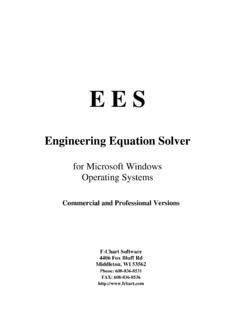Transcription of Mechanical Engineering Principles - Weebly
1 Mechanical Engineering PrinciplesThis Page Intentionally Left BlankMechanical Engineering PrinciplesJOHN BIRDBSc, CEng, CMath, FIMA, MIEE, FCollP, FIIECARL ROSSBSc, PhD, DSc, CEng, FRINA, MSNAMEN ewnesOXFORD AUCKLAND BOSTON JOHANNESBURG MELBOURNE NEW DELHIN ewnesAn imprint of Butterworth-HeinemannLinacre House, Jordan Hill, Oxford OX2 8DP225 Wildwood Avenue, Woburn, MA 01801-2041A division of Reed Educational and Professional Publishing LtdFirst published 2002 John Bird and Carl Ross 2002 All rights reserved. No part of this publicationmay be reproduced in any material form (includingphotocopying or storing in any medium by electronicmeans and whether or not transiently or incidentallyto some other use of this publication) without thewritten permission of the copyright holder exceptin accordance with the provisions of the Copyright,Designs and Patents Act 1988 or under the terms of alicence issued by the Copyright Licensing Agency Ltd,90 Tottenham Court Road, London, England W1P for the copyright holder s written permissionto reproduce any part of this publication should be addressedto the publishersBritish Library Cataloguing in Publication DataA catalogue record for this book is available from the British LibraryLibrary of Congress Cataloguing in Publication DataA catalogue record for this book is available from the Library of CongressISBN 0 7506 5228 4 For information on all Newnes publications visit our website at by Laserwords Pvt.
2 Ltd., Chennai, IndiaPrinted and bound inContentsPrefaceixPart 1 Statics and strength of materials11 The effects of forces on Tensile Compressive Shear Elasticity, limit ofproportionality and elastic limit Hooke s Ductility, brittlenessand Modulus of Thermal Compound bars132 Tensile The tensile Worked problemson tensile Further worked problemson tensile testing213 Forces acting at a Scalar and vector Centre of gravity and equilibrium The resultant oftwo coplanar Triangle of forces The parallelogramof forces Resultant of coplanarforces by Resultant of more thantwo coplanar Coplanar forces in Resolution of Summary374 Forces in Worked problems on mechanismsand pin-jointed Graphical Method of joints (amathematical method) The method of sections(a mathematical method)
3 52 Assignment 1555 Simply supported The moment of a Equilibrium and theprinciple of Simply supported beamshaving point Simply supportedbeams with couples646 Bending moment andshear force Bending moment (M) Shearing force (F) Worked problems onbending moment andshearing force Uniformly distributed loads787 First and second moment of The first moment of Centroid of area betweena curve and Centroid of area betweena curve and Worked problems oncentroids of simple Further worked problems oncentroids of simple Second moments ofarea of regular Second moment of areafor built-up sections96 Assignment 2102vi Mechanical Engineering PRINCIPLES8 Bending of To prove that y=MI= Worked problems onthe bending of beams1059 Couple and Work done and powertransmitted by a constant torque Kinetic energy andmoment of Power transmis-sion and efficiency11610 Twisting of To prove that r=TJ=G Worked problems onthe twisting of shafts122 Assignment 3126 Part 2
4 Dynamics12711 Linear and angular The Linear and angular Linear and angular acceleration Further equations of Relative velocity13212 Linear momentum and Linear Impulse and impulsive forces13913 Force, mass and Newton s laws of Centripetal Rotation of a rigidbody about a fixed Moment of inertia (I)14914 Work, energy and Potential and kinetic Kinetic energy of rotation165 Assignment 416915 Introduction to Coefficient of Applications of Friction on an inclined Motion up a plane withthe pulling forcePparallel to the Motion down a planewith the pulling forcePparallel to the Motion up a plane dueto a horizontal The efficiency of a screw jack17716 Motion in a Motion on a curved banked track Conical Motion in a vertical Centrifugal clutch18917 Simple harmonic Simple harmonic motion (SHM)
5 The spring-mass The simple The compound Torsional vibrations19618 Simple Force ratio, movementratio and The Gear Levers205 Assignment 5209 Part 3 heat transfer and fluid mechanics 21119 heat energy and The measurement of temperature Specific heat Change of Latent heats of fusionand A simple Conduction, convec-tion and Vacuum flask218 CONTENTS Use of insulationin conserving fuel21820 Thermal Practical applicationsof thermal Expansion and con-traction of Coefficient of linear expansion Coefficient of super-ficial Coefficient of cubic expansion225 Assignment 622921 Fluid Atmospheric Archimedes Measurement of Absolute and gauge The The Bourdon pressure Vacuum Hydrostatic pressureon submerged Hydrostatic thruston curved The stability of floating bodies 24222 Fluid Differential pressure flowmeters Orifice Venturi Flow Pitot-static Mechanical Deflecting vane Turbine type Float and tapered-tube Electromagnetic Hot-wire Choice of Equation of Bernoulli s Impact of a jet ona
6 Stationary plate25523 Ideal gas Boyle s Charles The pressure Dalton s law of partial pressure Characteristic gas Worked problems on thecharacteristic gas Further worked problems onthe characteristic gas equation26324 The measurement of Liquid-in-glass Resistance Temperature indicatingpaints and Bimetallic Mercury-in-steel Gas Choice of measuring device275 Assignment 7277A list of formulae279 Greek alphabet283 Answers to multiple-choice questions284 Index287 PrefaceMechanicalEngineeringPrinciplesai ms tobroaden the reader s knowledge of the basicprinciples that are fundamental to mechanicalengineering design and the operation of Engineering systems and products stillrely upon static and dynamic Principles to makethem work.
7 Even systems that appear to be entirelyelectronic have a physical presence governed by theprinciples of clarity, the text is divided intothree sections,these being:Part 1 Statics and strength of materialsPart 2 DynamicsPart 3 heat transfer and fluid mechanicsMechanical Engineering Principlescovers thefollowing syllabuses:(i)National Certificate/Diplomacourses inMechanical Engineering (ii) Mechanical Engineering Principles (Ad-vanced GNVQ Unit 8)(iii)Further Mechanical Engineering Principles (Advanced GNVQ Unit 12)(iv)Any introductory/access/foundation courseinvolving Mechanical Engineering Principlesat University, and Colleges of Further andHigher pre-requisites for the modules coveredin this book include GCSE/GNVQ intermediate inMathematics and Science,each topic considered inthe text is presented in a way that assumes thatthe reader has little previous knowledge of Engineering Principlescontains over280 worked problems, followed by over470 fur-ther problems(allwith answers).
8 The furtherproblems are contained within some130 Exercises;each Exercise follows on directly from the rele-vant section of work, every few pages. In addition,the text contains260 multiple-choice questions (allwith answers), and260 short answer questions,the answers for which can be determined from thepreceding material in that particular chapter. Whereat all possible, the problems mirror practical situ-ations found in Mechanical linediagramsenhance the understanding of the regular intervals throughout the text are some7 Assignmentsto check understanding. For exam-ple, Assignment 1 covers material contained inChapters 1 to 4, Assignment 2 covers the materialin Chapters 5 to 7, and so on. No answers are givenfor the questions in the assignments, but alecturer sguidehas been produced giving full solutions andsuggested marking scheme.
9 The guide is offered freeto those staff that adopt the text for their the end of the text, a list of relevantformulaeis included for easy reference. Learning by Example is at the heart ofMechanical Engineering Bird and Carl RossUniversity of PortsmouthPart 1 Statics and strength ofmaterials1 The effects of forces on materialsAt the end of this chapter you should beable to: define force and state its unit recognise a tensile force and state relevantpractical examples recognise a compressive force and staterelevant practical examples recognise a shear force and state relevantpractical examples define stress and state its unit calculate stress from =FA define strain calculate strain from =xL define elasticity, plasticity, limit of propor-tionality and elastic limit state Hooke s law define Young s modulus of elasticityEand stiffness appreciate typical values forE calculateEfromE= perform calculations using Hooke s law plot a load/extension graph from givendata define ductility, brittleness and malleabil-ity.
10 With examples of each define rigidity or shear modulus understand thermal stresses and strains calculates stresses in compound IntroductionAforceexerted on a body can cause a change ineither the shape or the motion of the body. The unitof force is thenewton, solid body is perfectly rigid and when forcesare applied to it, changes in dimensions occur. Suchchanges are not always perceptible to the humaneye since they are so small. For example, the spanof a bridge will sag under the weight of a vehicleand a spanner will bend slightly when tighteninga nut. It is important for engineers and designers toappreciate the effects of forces on materials, togetherwith their Mechanical three main types of Mechanical force that canact on a body are: (i) tensile, (ii) compressive, and(iii) shear2 Mechanical Engineering Tensile forceTensionis a force that tends to stretch a material,as shown in Figure For example,(i) the rope or cable of a crane carrying a load isin tension(ii) rubber bands, when stretched, are in tensionForceForceFigure (iii) when a nut is tightened, a bolt is under tensionA tensile force, one producing tension, increasesthe length of the material on which it Compressive forceCompressionis a force that tends to squeezeor crush a material, as shown in Figure Forexample,ForceForceFigure (i) a pillar supporting a bridge is in compression(ii) the sole of a shoe is in compression(iii)







